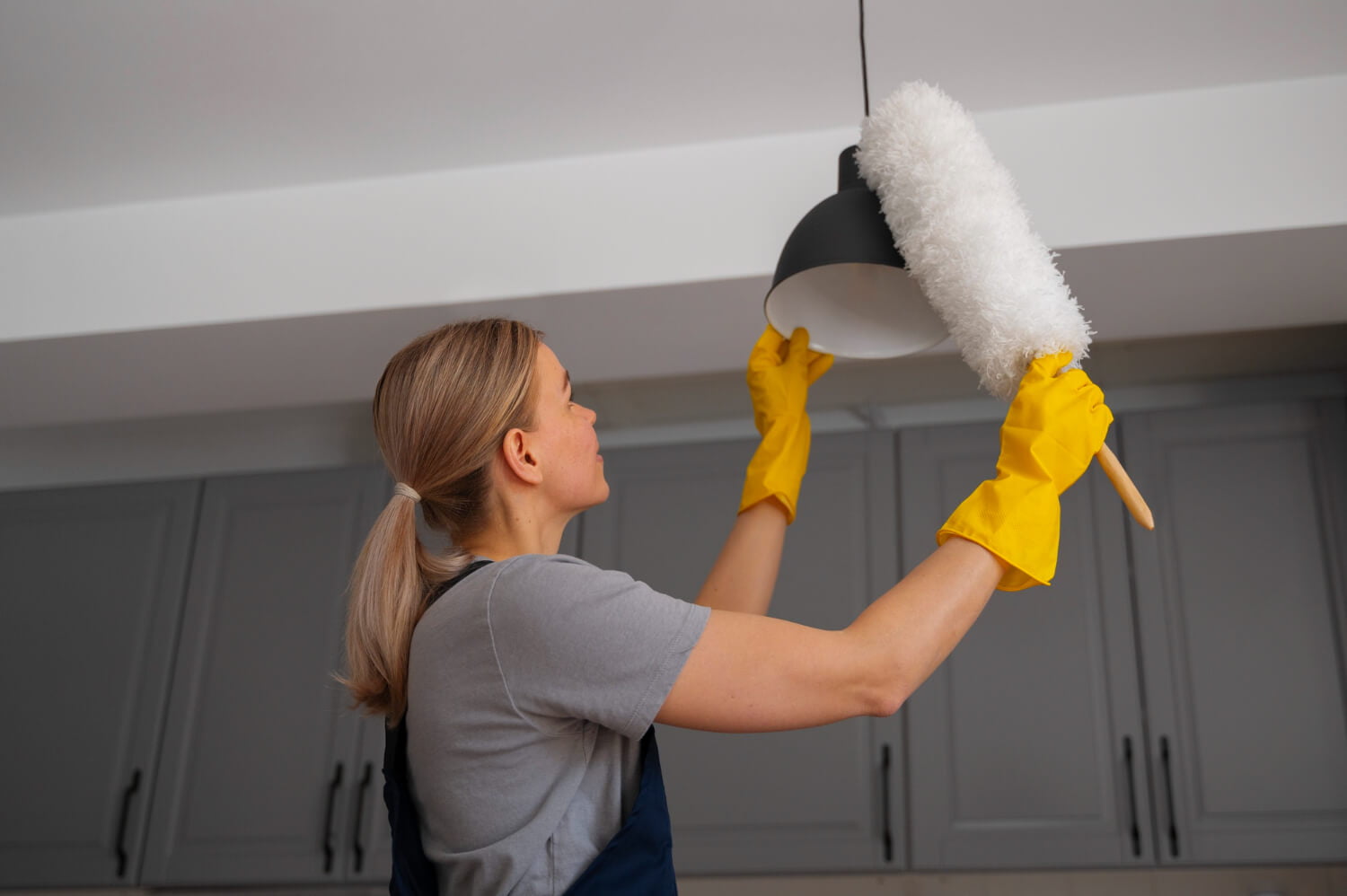As a busy homeowner, keeping every nook and cranny of your home sparkling clean can feel like an endless chore. Lamps seem innocuous enough, but their shades inevitably become dust magnets over time. While a quick dusting may remove surface debris, grime builds up in hard-to-reach crevices. Before you know it, your once-pristine lampshades look dingy and dated.
Don’t despair. With the right techniques and tools, refreshing lacklustre lampshades is totally doable. This guide will illuminate the methodology behind spiffing up shades of all styles and materials. Bid adieu to dusty dreariness, and let your lamps light up your living space with their best glow.
Table of Contents
Assessing Your Lampshades
Not all lampshades are created equal when it comes to cleaning. The first step is identifying what material your shades are made of, as methods vary accordingly. Here are some of the most common lampshade materials and what works best for each:
Fabric – Cotton, linen, canvas, silk and other delicate fabrics require a gentle touch. These shades trap dust easily in the weave.
Parchment/Paper – Rice paper and other laminated paper materials need moisture to clean fully. Oil from hands can also dirty parchment shades over time.
Glass/Plastic – From chandeliers to bedside lamps, glass and acrylic shades resist dust but attract smudges and fingerprints. Static cling makes them magnets for pet hair and dust too.
Metal – Shiny copper, brass, aluminium, and other metal shades just need occasional polishing to look gleaming and new.
Knowing the make-up of your lampshades allows you to customise cleaning techniques accordingly. Always check manufacturer’s care instructions too. Now let’s explore specific methods to refresh different shade types.
Fabric Lampshade Cleaning Tips
Delicate fabrics like silk require the most careful approach. Start by dusting the exterior with a microfibre duster or soft brush. For a deeper clean, use the following techniques:
- Vacuum using a soft brush attachment at the lowest suction setting. This lifts surface dust and debris from the fabric weave without abrasion.
- Spot clean stains by dabbing with a cloth dampened in warm, soapy water. For tougher spots, spray undiluted vinegar and dab gently.
- Steam fabric shades using a garment steamer to kill dust mites and germs. Keep the nozzle moving continuously to avoid water marks.
- Freshen up dingy cotton or linen shades by rubbing them with half a lemon. The citric acid cuts through grime, revitalising the colour.
- If needed, machine wash removable fabric shades in cold water on a delicate cycle. Air dry fully before reattaching to the lamp base.
With care and patience, fabric lampshades can be renewed to look as vibrant as new.
Paper/Parchment Shades: Smooth as New
Shades made of paper or laminated parchment materials call for slightly different cleaning methods. Follow this process:
- Dust first with a soft brush or microfibre cloth. This removes any loose particles and debris.
- Mix a solution of equal parts white vinegar and water in a spray bottle. Mist the shade lightly and wipe clean with a damp cloth.
- Use a gum eraser to gently lift any greasy spots or fingerprints. This works better than harsh chemical cleaners.
- For thorough disinfecting, dip a cloth in undiluted white vinegar and wipe down the entire shade.
- Smooth down any wrinkles or ripples with a cool hair dryer on the no heat setting. The airflow removes creases in paper or parchment.
With the proper diluted vinegar solution and eraser, you can keep paper and parchment shades looking crisp and bright.
Glass/Plastic Lampshade Cleaning Success
Glass and plastic lampshades attract dusty build-up through static cling. Smudges and fingerprints also stand out clearly. Here’s how to get them gleaming again:
- Dust first with a microfibre cloth to remove loose particles.
- Mix a solution of equal parts water and white vinegar. Dip a soft cloth in the solution and wipe down the entire shade.
- For tough smudges, spray undiluted white vinegar directly onto the spot. Let sit for 1-2 minutes before gently rubbing with a cloth.
- Clean between slats or crevices with a small soft brush dipped in the vinegar solution.
- Rinse the damp shade with a clean lint-free cloth. Wipe dry with a microfibre towel to prevent water marks.
The acids in white vinegar cut through grease and grime, leaving glass and plastic lampshades sparkling. It’s safe for most surfaces, but spot test first. With regular gentle cleaning, these shades maintain their crystalline shine.
Polishing Metal Lampshades
From vintage brass to modern chrome, metal lampshades add gleaming style. Keep them looking lustrous with simple polishing:
- Dust shades first with a soft dry cloth to remove any dirt or debris.
- Apply a small amount of metal polish to a soft cloth. Rub gently onto the metal surface using circular motions.
- Buff the shade carefully with a clean dry cloth until any residue is removed.
- For brass shades, rub with lemon oil to restore the warm glow and prevent tarnishing.
- Use a jeweller’s polishing cloth on intricate or etched metal shades to refresh grooves and details.
Frequent light polishing keeps metal shades brilliant, while lemon oil and a jeweller’s cloth tackle tarnish. With occasional upkeep, metallic lampshades maintain their sheen for years.
Lampshade Cleaning Tips and Tricks
Now that you know how to clean different lampshade materials, here are some extra pointers:
- Check for colourfastness on fabric shades by dabbing rubbing alcohol on an inconspicuous area first. If the colour bleeds, clean with a dry soft brush only.
- For fabric shades, sprinkle corn or wheat starch before vacuuming. The granules help absorb odours and freshen fabrics.
- Clean pleated lampshades one section at a time to avoid crushing the pleats.
- Rotate the direction of accordion-folded lampshades and clean crease by crease to reach all areas.
- Prevent dust build-up by placing fabric shades in a large sealing bag after cleaning. Squeeze out excess air and seal the bag.
- Use an artists’ paintbrush to dust intricate metal lampshades featuring cutouts or engravings. The fine bristles reach crevices.
With the right tools and techniques, cleaning lampshades is easy. Follow the material-specific guidelines outlined here. Add your own tricks like using starch or sealing bags, and your shades will sparkle.
Conclusion
Don’t let dusty lampshades dim your home’s style. Whether made of fabric, paper, glass or metal, all shade types can be refreshed. Tailor your cleaning method to the material, using our helpful guide. Vacuum and dust delicately, then clean thoroughly with solutions like diluted vinegar. With regular TLC, your lampshades will glow like new again. Contact Affordable Cleaning Services if you need a hand. Our expert cleaners can dust and clean any lampshade using non-toxic products and the latest techniques. Your lamps will shine bright once more.
FAQ:
✓Can I put fabric lampshades in the washing machine?
Only if the care instructions specifically indicate machine washing. Otherwise, it’s safest to vacuum and spot clean fabric shades by hand to avoid damage.
✓Is vinegar safe on all lampshade materials?
Diluted white vinegar is safe for most lampshades except untreated paper or antique fabrics. Always spot-test first. Undiluted vinegar can also be used for tougher cleaning jobs.
✓How often should I dust lampshades?
Fabric or parchment shades should be dusted weekly. Glass and metal shades can be dusted every couple of weeks. Frequent dust removal prevents buildup.
✓What’s the quickest way to remove fingerprints from a glass lampshade?
Mist undiluted white vinegar directly onto any fingerprints or smudges. Let sit 1-2 minutes before gently rubbing clean with a soft cloth. The vinegar cuts through oils for effective, fast fingerprint removal.






